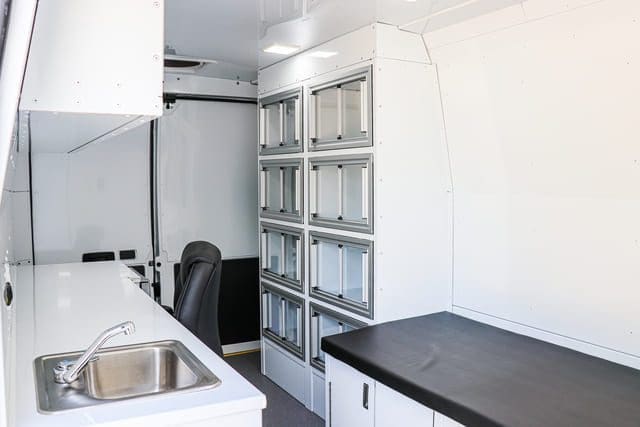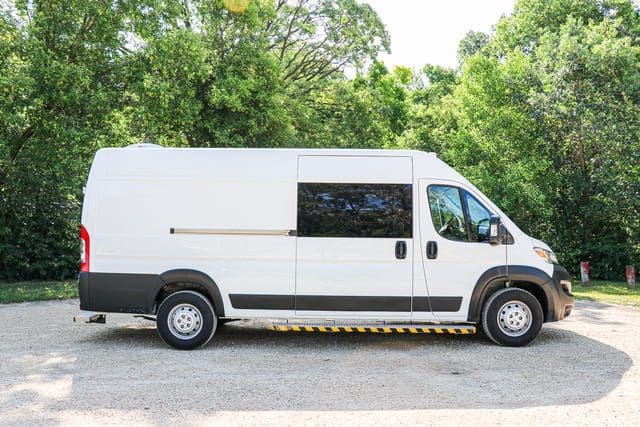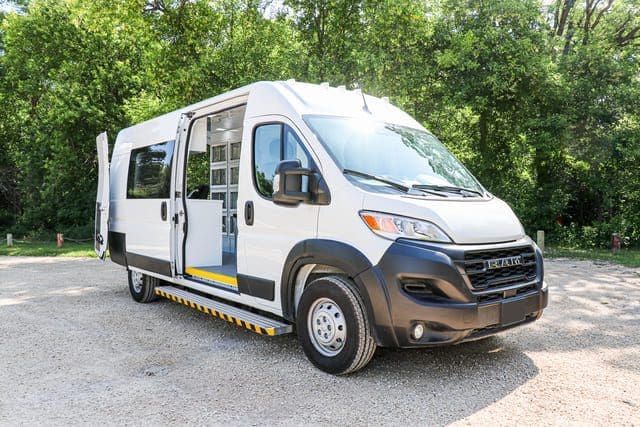Is your organization in the midst of deciding between mobile medical vans and RV clinics? Before making the final decision, you should be aware of the maintenance involved between these two options. Frequent maintenance leads to more downtime, patient inconvenience, higher operational costs, and reliability concerns.
At AVAN Mobility, we manufacture mobile medical vans for organizations that have the goal of reducing healthcare barriers across the U.S. Some of the organizations we work with are:
- Healthcare providers
- Senior living communities
- Native reservations
- Centers for Independent Living
- Outreach support organizations
In this article, you’ll learn about the maintenance involved between mobile medical vans vs. RV clinics. By the end of reading this article, you’ll have a better idea of which option will work for your organization.
What routine maintenance do mobile medical vans require?
Mobile medical vans, like ours at AVAN Mobility, play a vital role in providing healthcare to communities. To ensure these vehicles stay in top-notch condition and continue to serve their purpose effectively, routine maintenance is essential. Let’s delve a bit deeper into the key maintenance tasks.
Standard oil changes: Regular oil changes are an important part of mobile medical van upkeep. Just like we change the oil in our cars, it helps the van’s engine work smoothly. This task ensures that the engine’s moving parts stay well-lubricated and minimize wear and tear.
Tire care: Tires are the van’s connection to the road, and their condition is critical. Proper tire care includes:
- Rotating the tires regularly: This ensures even wear, extending their lifespan.
- Tire replacement every 36,000 to 75,000 miles: However, this can vary based on factors like driving habits, maintenance, and climate conditions.
In hot places like Los Angeles, for example, the sun’s scorching rays and high temperatures take a toll on the tires of mobile medical vans.
Mobile medical van vs. RV clinic maintenance

RV clinics are larger than mobile medical vans. Because of that, they have more maintenance tasks that need to be addressed.
RV clinic maintenance demands regular care and attention to ensure the vehicle’s optimal performance. Here’s a closer look at what’s involved:
Roof inspection: Regular roof inspections are crucial to prevent leaks and water damage. The roof is a vulnerable area, and routine checks are essential to maintain its integrity.
RV sides: Ensuring the sides of the RV clinic are in good condition is vital. This includes checking for any damage or wear and addressing it promptly.
Jack stands: Stabilizing the RV with jack stands is part of the regular maintenance. Ensuring these stands are in proper working order is essential for safety and stability.
Tires: Tire maintenance involves more than just tire rotations and replacements. It also includes monitoring tire pressure, alignment, and ensuring they’re roadworthy.
Electrical components: RV clinics often house various electrical components inside. These include safety switches, electronic parts, and circuit boards. Regular checks and servicing of these elements are necessary to maintain the vehicle’s electrical systems.
Conversion parts
Wheelchair accessible lifts: Some larger RV clinics feature wheelchair accessible lifts. These lifts come with safety switches, electronic components, and circuit boards, all of which require regular service to ensure their reliability.
Exam beds: Exam beds are important for patient care, and they need to be in proper working condition to provide a comfortable examination experience. They should be regularly inspected for signs of wear and tear.
Dental chairs: Dental chairs play a crucial role in providing dental care within the RV clinic. Keeping them in good condition is vital for patient comfort and safety.
Medical equipment: Regular maintenance of exam tables, diagnostic devices, sterilization tools, specialty seating, and other medical equipment plays a crucial role in healthcare accessibility.
Why do RV clinics experience more wear and tear?
RV clinics are like big medical clinics on wheels, and as you can imagine, they go through a lot. Here’s why they tend to wear and tear more than compact mobile medical vans:
Size: RVs are large and heavy, and because of their size, they tend to twist and expand as they move. This constant movement can lead to more extensive wear and tear.
Natural materials: RVs are built with different materials than mobile medical vans. While their natural materials might give off a cozy feeling, the material can warp depending on changes in temperature and humidity. It’s like how your door might not close right on a rainy day – the same thing can happen inside an RV.
So, RV clinics have some unique challenges because of their size and the materials used, making them more prone to wear and tear. Compared to a mobile medical clinic constructed on an OEM van, RV clinics undergo substantial modifications that impact their structural integrity, making them more prone to requiring service and maintenance.
How does fuel consumption differ between mobile medical vans and RV clinics?
Fuel consumption is one of the factors that you need to consider when choosing between a mobile medical van and an RV clinic. How much gas do these vehicles use, and how does that affect your budget and your environmental impact? Let’s take a closer look.
Generally speaking, larger RV vehicles have bigger engines that consume more gas. They can range from a V8 to a V10 engine, depending on the model and the manufacturer. These engines can give you more power and performance, but they also come with a higher fuel cost.
On the other hand, mobile medical vehicles are designed to be more fuel-efficient. At AVAN Mobility, our mobile medical vehicles come with a standard V6 engine, which is smaller and lighter than the RV engines. This means that they use less gas and emit less carbon dioxide. The fuel consumption in mobile medical vans is almost half the amount in some RV clinics. That can save you a lot of money and reduce your environmental footprint.
What factors affect fuel consumption between mobile medical units and RV clinics?
Your fuel consumption will vary depending on many factors. For example, if you drive in hilly or mountainous areas of the U.S., you’ll use more gas than if you drive on flat roads. If you drive at high speeds or with frequent stops and starts, you will also use more gas than if you drive at a steady pace. And if you carry a lot of equipment or passengers in your vehicle, you will add more weight and drag, which will also increase your fuel consumption.
So, when you are comparing mobile medical vans and RV clinics, don’t forget to factor in the fuel consumption. It can make a big difference in your operating costs and your environmental impact. Mobile medical vans are designed to be more fuel-efficient than larger RV vehicles, and they still offer plenty of space and functionality for your organization’s medical needs.
What’s the life expectancy of mobile medical vans?
Many organizations ask how long a mobile medical van will last. The answer depends on several factors, such as the quality of the vehicle, the maintenance schedule, the usage frequency, and the environmental conditions.
However, a general estimate is that a mobile medical van can last for about 20 years if properly cared for and serviced. This means that investing in a mobile clinic van can be a cost-effective and sustainable way to provide healthcare services to underserved communities, especially in rural or remote areas.
What happens if you need an emergency repair?
Sometimes, things can go wrong with your mobile medical van. Maybe the engine breaks down, or the equipment stops working. You might need to get it fixed right away, so you can keep helping people who need medical care. But how long will it take to fix your van?
In case of an emergency repair for an AVAN mobile medical van, here’s what you can expect:
Quick turnaround: If it’s a simple technical issue, the good news is that AVAN mobile medical vans can often be back up and running in a matter of hours to a week, depending on the specific problem.
Timely response: Our team understands that when it comes to mobile medical vans, every moment counts. We prioritize getting the van back in service as swiftly as possible to ensure uninterrupted healthcare support for communities.
Navigating your journey with AVAN Mobility

You came to this article looking for more information on the maintenance involved between mobile medical vans and RV clinics.
You learned that RV clinics require more maintenance and upkeep than mobile medical vans. That translates to higher overall long-term costs.
Our team at AVAN Mobility works hard to help organizations who help people. We offer four different mobile medical vans to provide accessible healthcare across the U.S. If you have any questions, don’t hesitate to reach out to us and talk to an expert.
At this point, you might be wondering about the costs associated with mobile medical vans. For more information on that, read our article on how a mobile medical unit costs in the U.S.
In addition, read our article on the process of buying a mobile medical van with AVAN Mobility.





